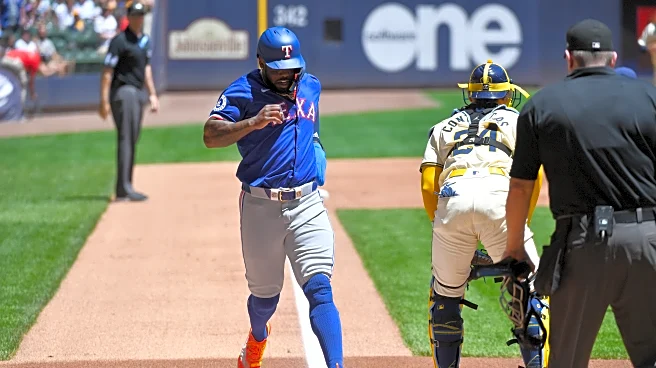It’s another week here at BCB After Dark: the coolest club for night owls, early risers, new parents and Cubs fans abroad. We’re so glad you decided to stop by. It’s always good to see a friendly face. There’s no cover charge. We still have a few tables available. Let us know if you need anything. Bring your own beverage.
BCB After Dark is the place for you to talk baseball, music, movies, or anything else you need to get off your chest, as long as it is within the rules of the site. The late-nighters
are encouraged to get the party started, but everyone else is invited to join in as you wake up the next morning and into the afternoon.
Last week I asked you if the Cubs should be interested in signing free agent right-hander Cody Ponce, who is returning from Asia after a successful stint in NPB and KBO. The comments were quite negative, but the votes were positive, as 46 percent of you thought a two-year, $18 million deal would be fair. Another 27 percent would sign him if the price were lower and four percent would sign him even if it cost more. Only 23 percent said the Cubs should stay away.
Here’s the part where we listen to music and talk movies. We’re deep into the BCB Winter Science Fiction Classic, but there’s always time to still get in on the fun. But you can skip that part if you want.
I promised some Thanksgiving jazz this week and I’m a man of my word. This is the brilliant young pianist Isiah J. Thompson in studio playing the Vince Guaraldi classic Thanksgiving theme from “A Charlie Brown Thanksgiving.”
Thompson is joined by Anthony Hervey on trumpet, Alexa Tarantino on alto sax, Julian Lee on tenor sax, Philip Norris on bass and Kyle Poole is the drummer.
You voted (well, some of you voted) in the BCB Winter Science Fiction Classic and it was another close one. There were very few votes but in the end, La Jetée came out one vote ahead of Alphaville. That’s good because while I like Alphaville, La Jetée is a flat-out masterpiece and Alphaville is maybe Godard’s fourth- or fifth-best film. Yes, second-tier Godard is better than a lot of other filmmakers best stuff, although third- and fourth-tier Godard is flat-out unwatchable. The drop-off between good Godard and bad Godard is steep. Alphaville is definitely in the good stuff.
I don’t know whether it’s just the time of year or a lack of interest in French films, but there were very few votes in this one. Just a reminder, you aren’t required to have seen the films to vote. It’s nice, but not required. You can vote for the film that you’d rather see if given the option.
Tonight we have a matchup of two films that both feature a world where humanity is enslaved by a higher, more powerful species. They are also both based on French novels, which makes me wonder what was going on in France in the late-fifties, early-sixties. (The Algerian War, I guess.) If you want to know which one was first, Planet of the Apes was the first movie made, the the novel that Fantastic Planet is based on came six years before Pierre Boulle’s ape novel.
2. Planet of the Apes (1968). Starring Charlton Heston, Roddy McDowell, Kim Hunter and Maurice Evans.
I grew up with Planet of the Apes. I must have been seven or eight years old when I saw it the first time on television. I would eventually see all five of the original films as well as the TV show. I had Planet of the Apes toys, Planet of the Apes comic books and book and record sets. I probably had Planet of the Apes pajamas, but I can’t remember for sure. I write this to explain that I really can’t remember a point in my life that I wasn’t aware of these talking ape movies. They were Star Wars a few years before Star Wars became a thing.
I’m going to assume that everyone who cares enough to read this has already seen Planet of the Apes, or at least is quite familiar with it. I can’t imagine that any of you aren’t familiar with the “shock ending” which means it lacks the ability to shock anymore. I’m going to run into the same problem when we get to the first Star Wars film. How do you separate the film itself from . . . (points around) . . . all this?
Going back and reading some of the contemporaneous reviews, it’s clear that making a movie called “Planet of the Apes” was a joke back in 1968 and that the critics were in various degrees surprised that the film didn’t stink. Some liked it, some liked it a lot and some still thought it was silly but no one thought it was the outright joke they thought it would be going in. They were appropriately surprised at the ending, which wasn’t in the book. In fact, very little of the Pierre Boulle novel made it into the movie.
What’s left is a world where the established social order is thrown upside down, with apes at top and humans as wild animals and experimental lab rats. The film also gets into the issues of faith versus science, going down a similar road of Inherit the Wind and the story of Galileo.
But those sorts of themes are subservient to the performance of Heston and the makeup job on the apes. Starting with the makeup, the Academy didn’t give out Oscars for hair and makeup back in 1968, but they awarded a special Oscar to makeup artist John Chambers because the ape makeup on Planet of the Apes was just that stunning. A lot of the feeling that this movie was going to be a joke was because of the fear that it would be actors running around in gorilla costumes from your local costume shop. Instead, Chambers created a real look for the apes that looked natural. Maybe the actors didn’t look exactly like chimpanzees, orangutans and gorillas, but they didn’t look silly and the actors were able to make facial expressions and actually act in the costumes. McDowell, Hunter and Evans, as doctors Cornelius, Zira and Zaius, give their parts a certain level of seriousness that could be lost in such a goofy concept. They are playing human beings who just happen to be apes.
Who doesn’t give seriousness to the film, and who gives Planet of the Apes much of its campy charm, is Heston, who turns in an old-style, over-the-top performance as Taylor. That sounds like criticism, but I don’t mean it as such. There are so many famous lines in this film and few of them would be famous if it weren’t for Heston’s big star performance. Would another actor have made these lines as memorable?
“Take your stinking paws off me, you damned dirty ape!”
“It’s a mad house! A mad house!”
“You did it. You cut up his brain, you bloody baboon!”
“You maniacs! You blew it up! Ah, damn you! God damn you all to hell!”
People still quote those lines, not because they are that great on the page but because Heston turned up his performance to eleven.
Planet of the Apes is also just an action adventure story, which, along with the ape makeup, is what fascinated myself and millions of other kids my age. Those factors, the music, the set design and the themes of the Cold War and science versus dogma, have made Planet of the Apes an enduring classic that they still keep re-making today.
The original trailer for Planet of the Apes.
7. Fantastic Planet (La Planète Sauvage) (1973). Directed by René Laloux. Written by René Laloux and Roland Topor.
The second film tonight also features a world where humanity has regressed to a primitive state and is ruled over by a superior race. Fantastic Planet is also the first of two animated features in our tournament, and its psychedelic artwork, along with the imaginative story, that has made the film a cult favorite over the decades.
A race of giant, super-intelligent blue humanoids called the Draags live on a distant planet named Ygam. Mankind is called the “Oms” (a near-homonym for the French word for man, “homme”) and they live in a primitive state on Ygam after being rescued from their own planet (presumably Earth) after they destroyed it. Some Draags keep Oms as pets, like you or I would keep a dog or cat, but most Oms live in the wild and are considered pests.
Fantastic Planet follows the story of a a orphaned baby Om (his mother was crushed by a Draag like you or I would crush a bug) who is found and taken in as a pet by a young girl Draag named Tiwa. She names the baby Om “Terr.” Tiwa and Terr are as inseparable as a young girl and her dog would be.
Tiwa starts her education through a giant headset. (Remote learning!) But there’s a flaw in Tiwa’s headset which allowed Terr to hear everything she hears, and thus he learns how to read and speak in the Draag language. The two have some adventures, but eventually Tiwa becomes a teenager and starts to develop interests outside the home, meaning she’s not spending much time with Terr anymore. So Terr escapes to the park, taking the headset with him.
In the park, Terr hooks up with colonies of Oms living on their own. They steal supplies from the Draags to survive. Eventually, the Draags get fed up with this and decide to exterminate all the non-domesticated Oms, much as we might try to kill any invasive species in a park.
The rest of the film is about the conflict between the Draags and the Oms, the secret behind the Draag’s meditation rituals and the ultimate resolution of the conflict.
There’s a lot of allegory going on in Fantastic Planet, but beyond a message of peace and undestanding, it’s surrealistic enough that it can mean a lot of different things to different people. You could argue it’s about animal rights, the holocaust, racism and civil rights, communism, ecological destruction or just man’s inhumanity to man. There are a lot of different things you could say it is about and you wouldn’t really be wrong. It’s certainly in line with early-seventies countercultural values, but beyond that, it’s vague and most likely intentionally so.
But the real thing that makes Fantastic Planet stand out is the hallucinogenic animation, based on the art of Topor. It’s hard to describe with words, although there is some similarities between it and some of the stuff that Terry Gilliam was doing with Monty Python around the same time. Fantastic Planet is far more grandiose, however.
Fantastic Planet is a beautiful and trippy animated film with a story that can be appreciated by young and old, although some parents would object to the animated nudity and implied sexuality in the film. It’s very much a product of the early-seventies, but its quality has caused it to remain as a cult classic even today.
Here’s the trailer for Fantastic Planet, which is going to make the case for the film more than anything I can write.
I assume you’ve seen Planet of the Apes, but if you want to re-watch it, it’s on the IndieFlix streaming service. I also found a copy on Dailymotion. Fantastic Planet is on HBO Max and Criterion in English and French, and there’s a copy in French (with English subtitles) on YouTube.
Now it’s time to vote!
You have until Wednesday to vote.
Coming up on Wednesday is director Stanley Kubrick’s magnum opus 2001: A Space Odyssey (1968). It takes on David Bowie in director Nicolas Roeg’s The Man Who Fell To Earth (1976). 2001: A Space Odyssey is on HBO Max. The Man Who Fell to Earth is on Kanopy (free with a library card) and The Roku Channel (free with ads).
Welcome back to everyone who skips that other stuff.
Even after the Cubs signed Phil Maton, the Cubs have let it be known that they are still planning to upgrade their bullpen. After all, Andrew Kittredge was traded back to Baltimore and Brad Keller, Caleb Thielbar, Drew Pomeranz and Taylor Rodgers all became free agents. So the bullpen still needs reinforcements and the Cubs have said as much. (The Athletic sub. req.)
One attractive free agent might be right-hander Pete Fairbanks. Fairbanks has been the Rays closer the past three seasons, raking up save totals of 25, 23 and 27 over the past three seasons. But the Rays declined his $11 million option for 2026, so he’s now a free agent.
The Cubs have been attached to Fairbanks as a possible free agent target. Ten days ago, Sahadev Sharma and Patrick Mooney called him a “name to keep in mind” (The Athletic sub. req.) as a free agent pursuit, although that was before they signed Phil Maton. In the article linked to earlier, the pair wrote:
But if the demand for late-innings relievers is that high, closers such as Devin Williams and Pete Fairbanks should be able to command hefty contracts that do not neatly fit into Chicago’s bullpen-building philosophy.
So it sounds like the Cubs are interested in Fairbanks if the price is right. What the “right price” is, we just don’t know at this point.
It’s clear why the Cubs would be interested in the 31-year-old Fairbanks. Besides just the closing experience and the career 3.19 ERA and the 2.83 ERA in 2025, he has a fastball that averaged 97.3 miles per hour last year. He’s also got a slider that comes in at 85.3 miles per hour and grades out as above average. He’s also been fairly healthy for a pitcher who throws hard. He threw 60.1 innings last year, which is a lot for a closer. He had a few trips to the injured list in 2023 and 2024, but they were both short ones and he managed to throw 45.1 innings in each of those years in 49 and 46 games.
If Fairbanks is so good, then why did the Rays decline to pick up his contract option for 2025? Well, the biggest reason is that these are the Rays and they just spent the 2025 season playing in a Spring Training park owned by the Yankees. But there were some on-field reasons to decline the option as well. For one, while that 97.3 mph fastball looks good, it’s down two miles per hour from his better days back in 2023. While Fairbanks struck out a very good 59 batters over those 60.1 innings last year, his strikeout percentage is down to 24.2 percent. That’s good, but it was 37 percent in 2023 and 43.7 percent back in 2022. Adding the fact that he turns 32 next month, the Rays probably think they got the best out of Fairbanks and decided to move on.
But the Cubs don’t really need Fairbanks to be a closer, although it would be nice to have him in reserve for that role should Daniel Palencia falter. Instead, they could use a hard-throwing right-handed set-up man. And while Fairbanks hasn’t been the same guy he was in 2022, he’s been a very good and mostly durable reliever for a long time. He’s solid and dependable. He may not throw as hard as he used to, but he still throws hard. He can close if necessary.
Fairbanks was also born in Milwaukee and went to high school in the St. Louis area. He might want to go somewhere closer to home. Yes, Milwaukee and St. Louis both have teams, but it’s not the Brewers style to spend on free agents and St. Louis is shedding contracts rather than adding them. Chicago would be close enough to both cities.
I put a contract offer up for Fairbanks at two years and $16 million. I think that might be a little high, but I know from previous years that whatever seemed reasonable in the year before turns out to be too little in this year’s market. If you want Fairbanks but think my estimate is too high, just vote for the “less money” option. But he’s not going to come on a one-year, $4 million deal.
Thank you for stopping by tonight. Please get home safely. Stay warm. Tell your friends about us. Don’t be a stranger. Recycle any cans and bottles. Tip your waitstaff. And join us again tomorrow night for more BCB After Dark.















